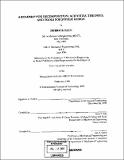A roadmap for decomposition : activities, theories, and tools for system design
Author(s)
Tate, Derrick (Derrick Edward), 1971-
DownloadFull printable version (20.09Mb)
Advisor
Nam P. Suh.
Terms of use
Metadata
Show full item recordAbstract
Many design theories lack scalability to systems with many elements. They provide guidance to designers about specific facets of a design task but are too cumbersome to apply thoroughly from conceptual to detailed design. Thus the opportunity for rational design is missed. Axiomatic design (AD) seems ideal for directing the design of large systems because it proposes general principles and a recursive design process. AD provides a fundamental basis for understanding decision making during design. It contains representations for the design object (a hierarchy of functional requirements, design parameters, and design matrices) and the design process ( decomposition and zigzagging) combined with rules for decision making (the independence and information axioms). Challenges remain, however, in implementing the theory to large system designs. The challenge addressed in this thesis is decomposition, the activity through which details of the design emerge. In decomposition, FRs satisfied by conceptual DPs are reduced into sets of sub-FRs. This activity is repeated until the design is completely embodied as a physical system of hardware and/ or software. A question asked about decomposition concerns consistency: How can decisions about sub-FRs, and the rest of the decomposed design, be made so that they match the design decisions and representations of the design that were made at higher levels of the design hierarchy? To enable designers to do this, this thesis extends AD by providing a model of the decomposition process that identifies the activities performed and provides guidelines and tools to assist the designers. The designers' goals and guidelines for achieving them have been generalized and evaluated for each of the decomposition activities: generating sub-FRs, identifying relevant customer needs, integrating sub-DPs, directing progress of the decomposition, dimensioning DPs, layout of DPs, carrying down and refining constraints, and ensuring consistency between levels. The theoretical concepts, the model, guidelines, and tools, have been validated through application to industrial cases including a new reticle management system accommodating customer variety, software algorithms for machine control, system analysis, reuse of design rationale, and software design. The cases examined cover a wide breadth, are from different fields, and have different numbers of designers.
Description
Thesis (Ph.D.)--Massachusetts Institute of Technology, Dept. of Mechanical Engineering, 1999. Vita. Includes bibliographical references (p. 137-144).
Date issued
1999Department
Massachusetts Institute of Technology. Department of Mechanical EngineeringPublisher
Massachusetts Institute of Technology
Keywords
Mechanical Engineering